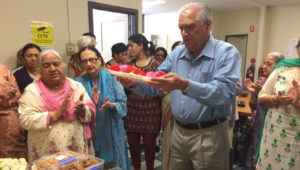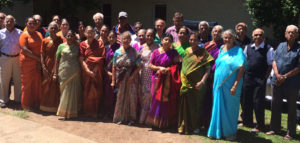Old age is catching up, so plan
By Vijay Badhwar & Kanwaljit Kanwar
Indian seniors at Indian Senior Hornsby Group
Now is the time that the community starts a serious conversation about the seniors: where and how they will spend their later lives, the care they may need and the options there are so that they are relatively in a conducive environment despite the limitations of a distant land and culture. So far we have buried our heads in the sand in the vain hope that our traditions will ensure the required support to our elders, unmindful of the circumstances and the pressures on our younger generation.
Already the Australian society is overwhelmed by the skewed need for more services for the elder generation – currently more than two million who are aged 70 and over. From the Indian community, although relatively young, early migrants from the subcontinent are gradually crossing the line, multiplying as well, thanks to the family reunion programme. There are already a sizable number of Indian seniors who are in dire need of services, estimated to be more than 25,000.
While the other migrant communities are far ahead in their planning for their seniors, the Indian community lags behind, limited to only a few motley groups who meet for a few hours a week ”“ for a yoga class and a lunch get together may be ”“ which, in itself, is worth its weight in gold, but does not extend itself to permanent or semi-permanent aged care.
Seniors celebrating Diwali at Sri Om Care Foundation Pennant Hills Group
Estimates are that by 2050 there will be 3.5 million seniors needing a range of services to be provided on self-funded basis or through income-tested government subsidised home care packages. They will be assessed for the level of care they will need by health care professionals from the Aged Care Assessment Team (ACAT). This can be arranged through website myagedcare.gov.au.
The level of home care ranges from low level (levels 1-2) to high care (levels 3-4) and includes domestic (cleaning, gardening etc) and personal, transport, shopping and medical services. The government funding starts at $7,822 per annum to $47,567 per annum depending on the level of care required. The recipients have to make co-payments that are capped.
From February this year, the seniors who avail the service will receive the funding directly from the Government so that they can themselves choose the provider and also vary the care to suit their requirements. It gives them flexibility to opt for better care by making additional payments.
The residential aged care in a nursing home, however, is a topic of concern for Indian seniors as they leave their familiar environment and are compelled to change their food habits and daily routines due to lack of a culturally conducive setup. An aged care facility becomes necessary as the level of care they may need for mental support as well as personal hygiene may become impractical to be provisioned by the family.
Seniors of Indian Welfare Association
Their cultural thinking, too, to leave something behind for their family comes in direct conflict with government planning that envisages drawing down from assets to provide for aged care. This, frequently, causes much heartache to families who are forced to put their assets on fire sale to pay for upfront deposits for entry into nursing homes.
Estimates are that approximately 45 percent of people more than 70 years old will use aged care services sometimes in their future. The basic accommodation deposits (refundable in part at the end of stay) vary depending on the standard and level of care facility and can be anything ranging from $450,000 to $950,000. People who do not own assets, for example, a property, are exempt from having to make a deposit.
The Government is generous towards aged care providers allowing them a deeming rate of interest they can charge their clients ”“ an exorbitant 6.28 per cent currently – in case they choose not to dispose of their assets to make the asking deposit. This is charged as a monthly payment on the amount the homes ask for as a deposit for the period of stay. As an example, if a nursing home asks for an initial $500,000 deposit, the client will be charged an approximate amount of $31,400 per year on top of other costs if they opt not to make the deposit. These costs may vary for different aged care facilities.
In Aged care four types of payments or deposit may be required:
Basic daily fee ”“ 85% of single age pension adjusted twice a year. It covers basic accommodation, meals and laundry but not medication. This is the only payment required if there are no other assets and/or income.
Seniors at Sri Om Care Foundation
Daily Accommodation Payment (DAP) ”“ It can either be bond money or interest currently around 5.76% for new residents, set quarterly:
- No accommodation costs: if income and assets are below a certain amount, the Australian Government will pay the accommodation costs
- An accommodation contribution: if you are required to pay part of the cost of your accommodation, the Australian Government will pay the rest
- An accommodation payment: if you are required to pay for the full cost of your accommodation, which varies according to the facility
Any assets disposed off or gifts made in the previous five years are still counted towards the calculation of the payments.
Means Tested care fee is an additional contribution towards the cost of care that some people may be required to pay. The Department of Human Services will work out if you are required to pay this fee based on an assessment of your income and assets, and will advise you of the amount.
For a member of a couple, half of the combined income and assets are considered in determining the means-tested care fee, regardless of which partner earns the income or owns the asset. The most someone can be asked to pay in means-tested care fees in a year is capped at $26,041.09 per annum and lifetime cap of $62,498.66 currently.
There are extra fees for a higher standard of accommodation or additional services. These vary from home to home and are negotiated between the provider and residents. Typically they range between $45 per day upwards ($16,000 plus per annum). Then there is additional daily contribution towards cost of care which some people have to pay for as well as if they opt for hotel-like services to increase their level of comfort ”“ a bigger room, choice of menu and recreational activities.
A few young seniors from the Indian community have already bought with other couples into independent units in aged care facilities in Normanhurst, Epping and Dural. They are quite satisfied with their move as they have company of their friends and their everyday chores are cared for.
Those who are enamoured by Hollywood movie ”˜The Best Exotic Marigold Hotel’ may consider to spend their years away from western loneliness in a familiar environment as there are a variety of facilities in India that specially cater to NRI needs. These do not demand huge upfront deposits and are relatively affordable with charges around $750 a month for accommodation and basic food that can be easily covered by Australian pension (check from The Department of Human Services for eligibility criteria).
Of course, it is a big decision to make as a part of you is left behind, in some cases, the family, and in others, family-like friendships.
Short URL: https://indiandownunder.com.au/?p=8427




